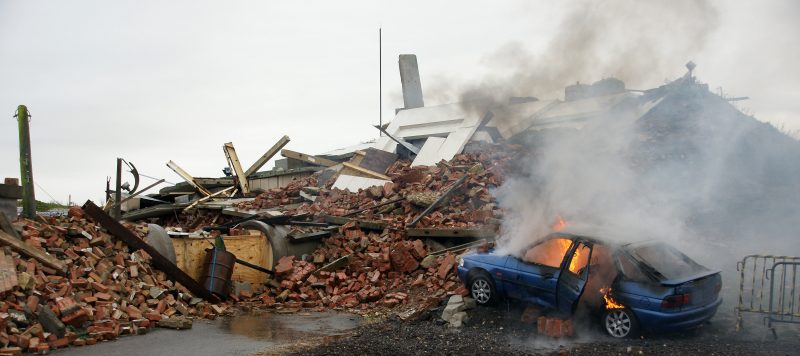EMQ » April–June 2022 » Volume 58 Issue 2
By Anna E. Hampton

One of the first places we see crisis mitigation in the Bible is in Genesis 41. Joseph interprets the Pharaoh’s dream about a massive impending food crisis. Pharaoh then gives Joseph responsibility to implement a detailed crisis management plan to help Egypt survive a seven-year drought. Joseph organizes Egypt for crisis preparation and response. Mobilizing a nation means asking entire communities to help. Community response to this crisis is critical. It requires planning, mobilizing, training, administration, and implementation.
Crises are an unavoidable part of global missions. The 10/40 window, where most unreached people groups live, is particularly vulnerable.[1] Global terror mapping shows that this region contains the largest percentage of terror attacks. It also has 46 of the 50 most gospel-hostile nations on earth. But the current war in Ukraine reveals that this is not the only region susceptible to serious calamity. While crises may be inevitable, their affects are not. Impact is dependent on our preparation and response. Following Joseph’s example, we can learn to do both of those well.
What is a Crisis?
According to Karen Carr, a crisis is “a time-limited traumatic event that demands a response or some sort of intervention.” While it is temporary, she explains that it feels as though it has no end or exit. She goes on to describe it as usually accompanied by uncertainty with elements of disequilibrium and disorganization. She says participants in it often do not think or plan well and experience paralysis of thought or will, intense fear, and exaggerated defense mechanisms including rationalizing, blaming, and compensation.[2]
The war in Ukraine shows us the variety of ways a crisis can affect missions. Missionaries and the people they serve within Ukraine face decisions to evacuate or stay. Ukrainian missionaries sent out from Ukrainian churches must deal with the acute pain of being far from family and friends in dire distress. Then in regions further way, missionaries may deal with related residual situations from food and supply shortages to rapid political responses that may change their visa status.
How can we prepare for these types of scenarios?
Crisis Planning and Response
Crises have three stages: pre-crisis, managing and responding to the crisis, and post-crisis care and recovery. Crisis management includes both preparing for crisis and then responsively caring for people after the crisis. Real crises are unpredictable, so effective crisis management plans must have enough structure and flexibility to enable agile decision-making as a crisis unfolds. A wholistic response to those in crisis includes practical, emotional, spiritual, and relational components provided by a team of skilled people. This creates a path to healthy and flourishing recovery.[3]
Crisis plans are usually not one-size-fits-all. Planning for crises is situational. Therefore, preparation starts with considering the question: What could happen? This identifies the main threat(s) to a gospel-focused project. The next question is How do we minimize the crisis impact so we can still reach our desired goals? This moves us toward ways we can mitigate crisis effects so that project work can still reach hoped for outcomes.
To minimize the impact of the crisis, mission personnel also need to have plans in place for crisis response as part of their crisis management plan. There are several essential skills for effective crisis response: information gathering, assessing (knowing what to look for and how to ask questions), listening, responding in ways that do not cause further harm, educating, mobilizing support systems, making action plans, and referring.[4]
Because crises never go according to the best plans, instilling a culture of regular reviews and updates is essential. Regular implies a cycle of review congruent with the situation. For example, if a team is in a situation of instability and likely crisis, then plans may need to be reviewed monthly. If a team is in a more stable situation, then perhaps once a year is acceptable. Each situation should be considered uniquely, not planned as a one-size-crisis-contingency-plan-fits-all.
Why Bother?
We must acknowledge that crises happen whether we plan for them or not. However, preparing for crisis allows us to be good stewards of time and resources which enables us to continue to serve in gospel witness. Crisis planning lowers stress, increases resiliency, communicates care, increases trust in leadership, and results in more buy-in and loyalty from staff both on and off the field as well as from sending churches.
Crisis management is also missional. Trauma affects the psychological homeostasis of a person. This leads to psychological disruption, but the level of severity is buffered by protective factors such as community support, good mental health and stress management, along with a solid theology of suffering.[5]
Jesus taught, “By this, all people will know that you are my disciples, if you have love for one another,” (John 13:35). In Afghanistan, we had frequent life-and-death crises! We experienced the reality of Jesus’ teaching when the international community of expatriates began to love each other better by resolving conflicts, graciously working together, and helping others through crisis. When we did this across agencies, across denominations, and across ethnic backgrounds, we put the love of Christ on display. It was then we saw more eternal decisions among Afghans than any time previously.
Training and Help in Crisis
Knowing what one’s threshold for deciding to leave a situation and when it is safe enough to return, knowing what plans need to be in place if staff choose to stay in dangerous situations – these are all part of planning for any type of crisis from war to natural disasters. Training can help you manage and create plans for any of these types of crises.
Doing crisis management well requires educating staff at the organizational, team, and individual level. Many crisis training entities serve the global Church. In the USA, churches and mission organizations can turn to companies like Concilium[6] or Crisis Consulting International[7] to learn how to do crisis management.[8]
One of the best crisis response trainings available originated from Mobile Member Care (MMCT 2020)[9] Team in West Africa. This training equips peer responders within communities to effectively help others cope with crisis. Barnabas International also offers both Crisis Response Training (CRT) and Risk Assessment Management (RAM) training.[10]
Conclusion
Crisis planning increases the likelihood that people are prepared to face difficult life-threatening situations and have the resilience needed to recognize the moment of courage when they need to sacrifice at great personal cost. Crisis planning, when done right, is righteous stewardship – God gave us minds to think and plan. But while we do the best we can in crisis planning, no matter what happens, our ever present God still redemptively works.

Anna E. Hampton, DRS (annahampton00@gmail.com), is a global risk consultant and author of Facing Danger: A Guide Through Risk. Anna and her husband, Neal, have almost thirty years of ministry experience, including raising their family for ten years in Afghanistan and five in Turkey. They serve with Barnabas International, providing pastoral support to missionaries ministering in dangerous areas of the world. Learn more about their ministry online: theologyofrisk.com.
[1] “People Groups of the World,” Great Commission Maps, Joshua Project. Accessed March 19, 2022. https://joshuaproject.net/assets/media/maps/progress-scale-map-1040.pdf.
[2] Karen F. Carr, Crisis Response Training Manual (Barnabas International, 2020), 4.
[3] Carr, Crisis Response Training Manual, 2.
[4] Carr, Crisis Response Training Manual, 70.
[5] Frauke Schaefer, “Section 4: Healthy Stress Management,” in Trauma and Resilience: A Handbook Effectively Supporting Those Who Serve God, eds. Charlie and Frauke Schaefer. (Schaefer & Schaefer, 2012).
[6] Concilum, https://concilium.us.
[7] Crisis Consulting International, https://cricon.org.
[8] This document lists global resources for training in risk assessment, crisis management, and crisis response. https://drive.google.com/file/d/1NxtNS17gdv7_8gbzg8m9cbzwbYKi_IdU/view
[9] “Crisis Response Resources in English,” Mobile Member Care Toolbox. Accessed March 19, 2022. http://www.mmct.org/cr-resources-in-english/
[10] “Risk Assessment and Management (RAM) Training,” Barnabas International. Accessed March 19, 2022. https://www.barnabas.org/ram-training
EMQ, Volume 58, Issue 2. Copyright © 2022 by Missio Nexus. All rights reserved. Not to be reproduced or copied in any form without written permission from Missio Nexus. Email: EMQ@MissioNexus.org.






Responses